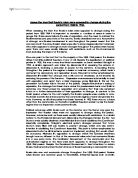The Communist regime also had a belief in a ‘higher purpose’ to rule, much like the Tsarist regime. Lenin’s belief that history had appointed him was a huge burden of responsibility upon him, much like the Tsars before him had a strong responsibility to maintain autocracy, shaped by the ideological belief that the Tsar was divinely appointed. Even though the communist regime looked ahead with their reforms, in contrast to the backward nature of the Tsars, both were implemented in the same authoritarian way. When implementing collectivisation and the 5 year plans, Stalin sought to maintain total control over the workers whilst eliminating any trace of opposition in order to maintain his authority. Nicholas II also took this approach in the October Manifesto, the Duma was in theory a step towards democracy but much like Lenin’s NEP, was implemented in an authoritarian way to limit the effect on power. The Communists introduced reforms, and concessions where necessary, in order to maintain their authority, such as Lenin’s abandonment of war communism for NEP, whereas the Tsars took the same approach by only introducing reform when pressurised as Alexander II’s assassination, and his prior implementation of the Emancipation Act shows. The regimes displayed their authoritarian nature in different ways, Lenin saw that war communism was not working and replaced it with NEP, whereas Alexander III put his stamp on Russia by reversing all of his father’s reforms.
There was also continuity in the nature of Government with the Communists retaining a strong belief in personal authority, Lenin retained all key decisions as the Tsars did before him. Both Communist and Tsarist Governments developed into authoritarian regimes because their authority was largely unchallenged once established. The removal of Khrushchev by the Central Committee and the abdication of Nicholas II in 1917 by comparison were insignificant as neither event managed to have a significant impact on the nature of Russian Government.
Despite the success of the 1917 revolutions Russia simply switched from one authoritarian regime in tsardom to another in communism. Lenin is constantly argued to be a ‘red Tsar’, because he was just as autocratic as the Tsars before him, despite not having absolute authority. Tsarist repression was intensified through the use of the Cheka, and the situation became far worse under Stalin than at any point under Romanov rule. So in that sense, there was little change to the authoritarian nature of Russian rule, and Russia had simply exchanged one authoritarian regime for another.
Both Tsarist and Communist Governments maintained their authority through heavy use of repression and censorship. The threat of death, exile and imprisonment was used by the Russian state throughout the period, with Lenin intensifying Tsarist repression following a brief relaxation in Nicholas II’s 1905 concessions. The failure of the Kronstadt mutiny demonstrated communist intolerance for opposition which Stalin would go on to intensify to unprecedented levels. Despite relaxation under Khrushchev, Stalinist repression had wiped out any opponents with similar effect to Alexander III and Lenin’s use of the Okhrana and Cheka respectively. Unlike Tsarist Governments where repression had provoked opposition and increased tensions, repression and clever use of propaganda under communist Governments removed any possibility of opposition succeeding.
The Communists were more effective autocrats than the Tsars in controlling the Russian people. Alexander III had driven opponents underground but his predecessor and successor would not share that success. The communists had effectively wiped out opposition as even potential threats were targeted, as opposed to the Tsars who only targeted known opponents. Stalin’s use of denunciations, purges and show trials and Lenin’s complete intolerance had the opposite effect is in stark contrast to Alexander III’s repressive nature towards revolutionaries.
Opponents to both regimes saw little success, and one reason is the continuing role which the army played in limiting opposition, with military force frequently being deployed throughout the period. Lenin used it in the Civil War against the Green armies of the peasantry and Stalin used a similar style of brute force during the collectivisation process, albeit on a much grander scale. Tsars had also used military force in containing opponents, with Stolypin’s necktie under Nicholas II and Alexander II continually employing military force prior to the Emancipation Act. The army was very important to the state, as the 1905 revolution demonstrated, and their continuing use of force against opponents is one way in which they successfully maintain their authoritarian regimes.
When the February Revolution brought an end to Tsardom, the newly instated Provisional Government aimed to bring a new age of democracy Russia. However the instatement of the communists in the October Revolution ensured that in the long term, Russia simply exchanged one authoritarian regime for another. Lenin defended his revolution in the Civil War and went on to continue and intensify many aspects of Tsarist autocracy, which Stalin would continue. This ensured that the communist regime was just as authoritarian as the Tsars had been before them, and they were more effective in doing so.








